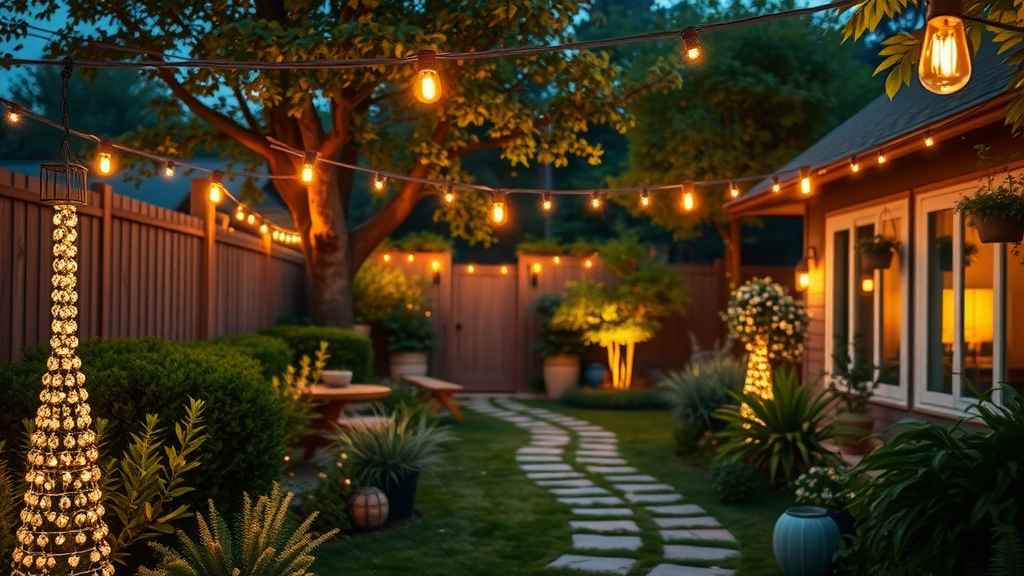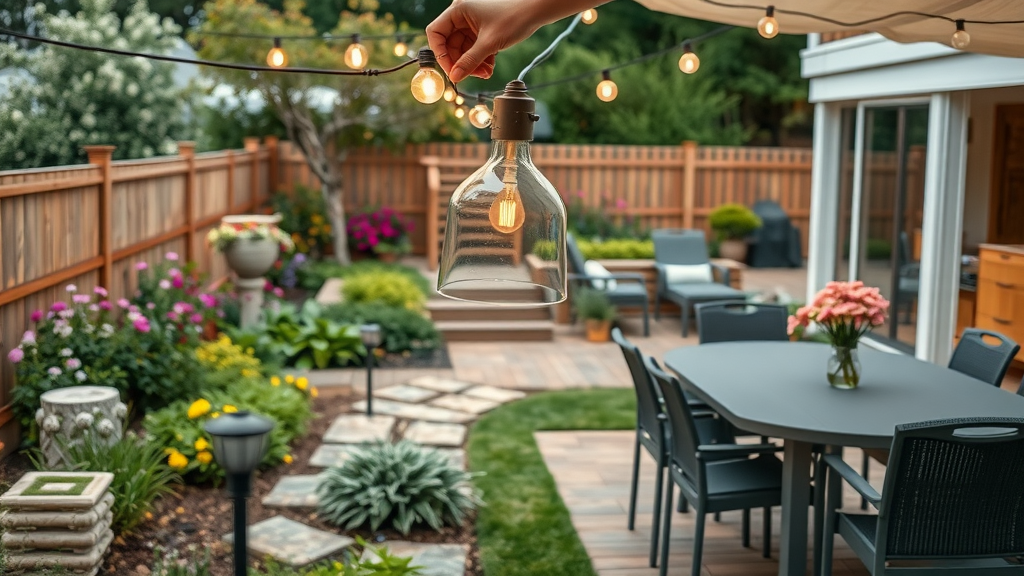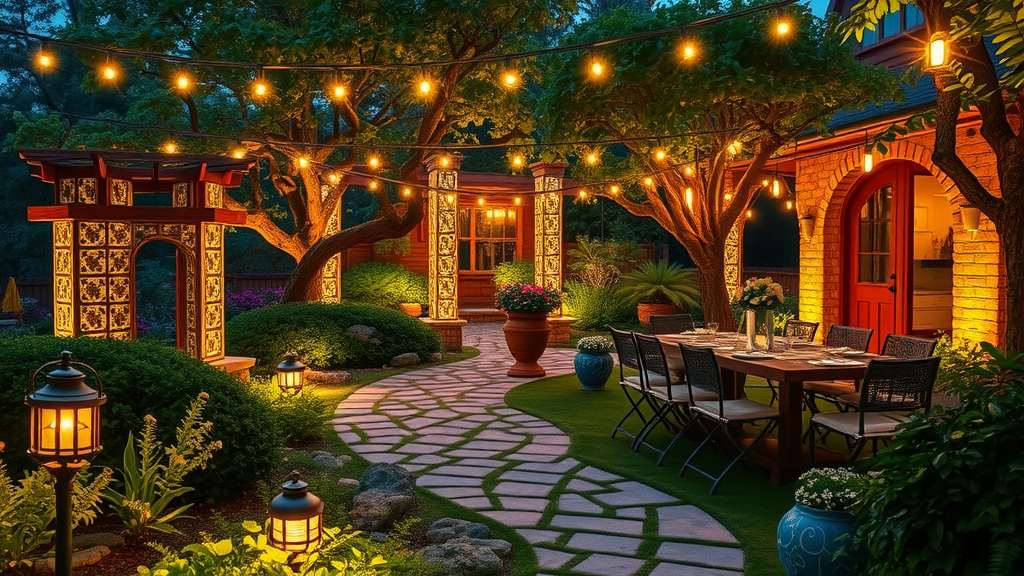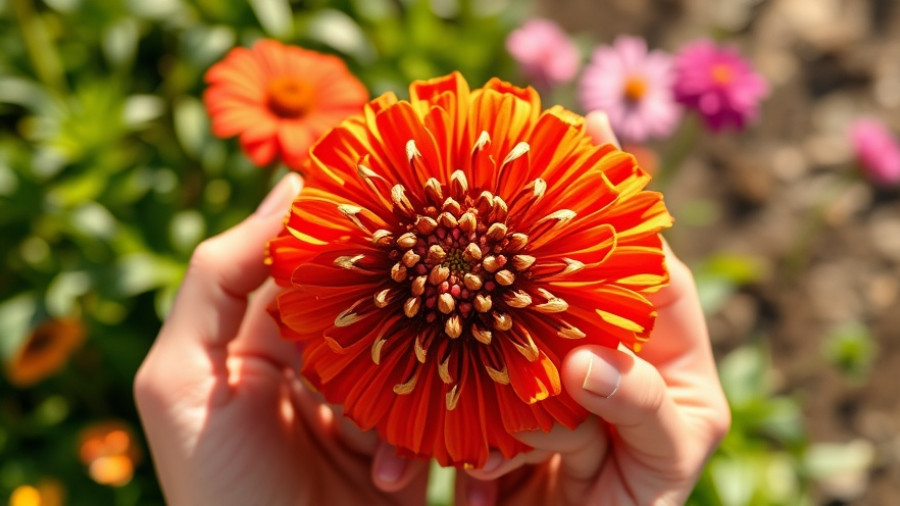Did you know that well-designed outdoor lighting can increase your home’s perceived value by up to 20%? Beyond aesthetics, strategic outdoor light fixture choices can also boost security and transform your backyard into a magical retreat. If you’ve wondered how the right choice of path light, string lights, or pendant light could elevate your nightly gatherings or safeguard your property, you’re in the right place. This guide demystifies outdoor lighting, helping you select, install, and maintain stunning, energy-efficient lighting for every corner of your exterior spaces.
How Outdoor Lighting Elevates Your Home’s Aesthetic and Safety
Outdoor lighting does more than just banish shadows; it creates a warm glow that turns the ordinary into the extraordinary. A well-placed path light guides visitors safely while also highlighting the natural beauty of your landscape. Whether you’re seeking to host late-night dinners or enjoy quiet evenings, outdoor lighting options like string lights and pendant lights can craft an ambiance tailored specifically for relaxation or entertainment.
From illuminating dark entrances to spotlighting gorgeous trees, light fixtures add both practical safety and inviting curb appeal. A combination of wall lights and landscape lighting strategically placed in outdoor areas can transform the look of your home after dusk, ensuring guests are welcomed by a festive feel and reducing potential security hazards. If you want your outdoor space to be as functional as it is beautiful, investing in high-quality outdoor lighting is the first—and most transformative—step.
- Increase property attractiveness and value with designer outdoor lights
- Boost security by illuminating paths, entrances, and dark corners
- Set the perfect mood for entertaining or relaxing

Types of Outdoor Lighting: Find the Perfect Outdoor Light Fixture
Choosing the right outdoor light fixture involves considering function, style, and the specific needs of your outdoor spaces. Common options include path lights for safe walkways, string lights that deliver a festive feel to patios, and pendant lights for a bold focal point in covered areas. These fixtures not only offer aesthetic benefits—a well-lit path light can provide guidance and charm—but also practical lighting to illuminate and secure your outdoor areas. For accent lighting, wall light fixtures frame entryways and add layers to your home’s nighttime appearance.
Other popular outdoor lighting options include solar lights for sustainability, LED bulbs for efficiency, and smart-compatible light fixtures for today’s modern homes. Whether you want to highlight a landscaped garden, brighten a front porch, or bring life to your backyard, there’s an outdoor lighting solution tailored for every need and design preference.
| Type | Best For | Key Features |
|---|---|---|
| Path Light | Walkways, gardens | Low voltage, solar options |
| String Light | Patios, pergolas | Weatherproof, LED bulb string |
| Pendant Light | Porches, dining areas | Statement piece, varied styles |
| Wall Lights | Entrances, accent | Motion sensors, energy saving |

As you explore fixture types and design options, it’s helpful to stay ahead of the curve by considering the latest innovations. For a closer look at what’s trending in outdoor lighting, including new technologies and design inspirations, check out the emerging outdoor lighting trends for 2025 to ensure your space remains both stylish and functional.
Choosing Outdoor Lighting: Practical Considerations and Planning
When planning your outdoor lighting installation, begin by assessing the size and function of your outdoor areas . Consider how different zones—such as pathways, gardens, and sitting areas—will be used. Effective lighting design often incorporates a mix of path lights, string lights, and accent fixtures to create a harmonious glow and clear lines of sight. Layering these types of lights ensures both safety and ambiance throughout your outdoor spaces.
The next practical step is selecting fixtures crafted for durability. Weather-resistant, IP65-rated or higher light fixtures withstand outdoor conditions—rain, snow, and sun—year-round. Opt for outdoor lighting that’s both rugged and stylish, such as stainless steel pendant lights or UV-protected solar path light options. For convenience and efficiency, prioritize LED or solar-powered lights that offer long-lasting performance and lower energy costs.
- Assess outdoor area size and usage
- Choose durable, weatherproof light fixtures
- Layer lighting: ambient, task, accent
- Select energy-efficient options (LEDs, solar-powered)
Popular Outdoor Light Fixture Styles to Transform Your Space
The right light fixture style can elevate any outdoor space , reflecting your personal taste while maximizing usability. Contemporary pendant lights offer a sophisticated, modern look for outdoor dining and lounging areas. Their design often features clean lines and innovative materials, making them ideal for patios and covered porches. For a cozier vibe, vintage-inspired bulb string lights bring warmth and personality, perfect for festive gatherings.
If you lean toward minimalist design, slim and simple path lights seamlessly blend into modern landscapes, providing subtle but effective illumination along garden beds, walkways, or driveways. For timeless elegance, classic carriage outdoor light fixtures deliver charm and visual interest to entryways and garages. Mixing different styles of light fixtures lets you layer lighting creatively, balancing function with coordinated aesthetics.
- Contemporary pendant lights for patios
- Vintage-inspired bulb string lights for cozy ambiance
- Minimalist path lights for modern landscapes
- Classic carriage outdoor light fixtures for elegance
Easy Outdoor Lighting Installation: DIY and Professional Options
Today’s outdoor lighting products make it easier than ever to brighten your landscape—whether you prefer tackling a project yourself or hiring a professional. Solar path lights and plug-and-play string light fixtures are perfect for homeowners who want instant results without advanced tools or wiring. Set-up can be completed in minutes, making it simple to enhance driveways, walkways, and patios with consistent, safe illumination.
For covered seating or dining areas, plug-in pendant lights provide both style and practicality, while low-voltage outdoor lighting kits offer a safe DIY solution for larger installations. These kits often include all the necessary cables, connectors, and fixtures, making outdoor lighting installation accessible even to beginners. If your design is ambitious or includes hardwired systems, partnering with a professional ensures compliance with local building codes and delivers polished, worry-free results.
- Solar path light & string light setup in minutes
- Plug-in pendant lights for covered areas
- Low-voltage outdoor light kits for safe DIY projects

Energy-Efficient and Solar-Powered Outdoor Lighting Solutions
Modern outdoor lighting is not just beautiful—it’s also eco-friendly and wallet-friendly. LED string lights are a popular choice for patios and decks, producing a consistent warm glow while using a fraction of the electricity required by traditional bulbs. Their long lifespan means fewer replacements and less maintenance over time.
For enhanced security, motion-activated LED outdoor light fixtures ensure that even infrequently used side yards, garages, or entryways are well-lit only when necessary, saving energy without sacrificing safety. Increasingly, homeowners are opting for solar path light and pendant lights, reducing reliance on the grid and cutting installation costs since no wiring is needed. These outdoor lights are ideal for eco-conscious setups and make sustainable living effortless and stylish.
- LED string lights for patios and decks
- Motion-activated LED security outdoor light fixtures
- Solar path light and pendant lights for eco-conscious homes
Top Outdoor Lighting Brands and Products Reviewed
Investing in trusted brands can make all the difference when shopping for outdoor lighting that lasts. Here are top-rated products for every use, based on user ratings and suitability for varied outdoor spaces.
| Product | Type | Best For | User Rating |
|---|---|---|---|
| Govee Outdoor String Lights | String Light | Patios & parties | 4.8/5 |
| Philips Hue Calla | Path Light | Garden walkways | 4.7/5 |
| Progress Lighting Pendant | Pendant Light | Covered porches | 4.6/5 |
Customer Reviews: Real Experiences with Outdoor Lighting
"The new pendant light over our porch completely transformed the space – installation was so simple! Our outdoor lighting makes every evening feel special." — Amanda R.
- "Switched to solar-powered path lights—love the glow and zero wiring!" — Carlos T.
- "String lights from Govee made our backyard parties unforgettable." — Jenna A.
Key Features to Consider When Buying Outdoor Lighting
When you’re ready to upgrade your outdoor lighting , keep these key features top of mind. Opting for weatherproof rating—especially IP65 or higher—means your fixtures can stand up to rain, snow, and sun. Energy efficiency is critical, making LED or solar technology the gold standard for sustainability and cost-savings.
Look for outdoor light fixture options with adjustable brightness and integrated dimmer functions to set the perfect ambiance and accommodate any activity, day or night. Compatibility with home automation systems is becoming increasingly common, allowing for voice control, scheduling, and remote management through your smartphone—the ultimate in outdoor lighting convenience.
- Weatherproof rating (IP65 or above preferred)
- LED or solar technology for efficiency
- Adjustable brightness & dimmer functions
- Compatibility with home automation systems
Outdoor Lighting Maintenance Tips & Best Practices
Keep your outdoor lighting shining bright and safe with a few simple maintenance steps. Begin by regularly wiping down fixtures and lenses to remove dirt, cobwebs, and water spots that can dim your lights. Annual inspections are a smart way to check for moisture concerns—replace gaskets and seals promptly to prevent electrical issues and maintain optimal weather resistance.
Stay proactive by changing out burned or failing bulbs to preserve consistent brightness, particularly in a string of path or string lights. Upgrading your system to smart controls or easy-use timers offers additional convenience, helping to automate your outdoor lighting schedule for security and aesthetics alike.
- Wipe fixtures and lenses regularly
- Check for moisture and replace gaskets annually
- Switch out bulbs as needed to maintain even lighting
- Upgrade to smart controls and timers for convenience

Inspiration: Outdoor Lighting Ideas to Transform Your Space
If you’re seeking outdoor lighting inspiration, consider these creative ideas for making your garden or patio unforgettable. Line walkways with solar path lights for a welcoming, enchanting approach, or drape overhead bulb string lights for an instant festive feel perfect for evening gatherings.
For even more impact, mix pendant lights with wall lights to layer lighting and create depth, or use spotlights and uplighting to highlight specimen trees, water features, or architectural details within your landscape lighting scheme. Experimenting with combinations and placement lets you discover new ways to bring out the beauty and magic of your outdoor spaces every night.
- Line walkways with solar path lights for a magical entrance
- Drape bulb string lights above patios or pergolas
- Mix pendant lights with wall lights for layered effect
- Highlight landscaping with spotlights and uplighting

Video Review: Comparing Outdoor Lighting Products
Watch side-by-side comparisons of today’s most popular outdoor lights, including Govee’s string lights, Philips Hue Calla path lights, and Progress Lighting pendant fixtures. See how each product performs in real outdoor spaces—helping you choose the best fit for your needs and personal style.
Video Tutorial: Installing Your Own Outdoor Lighting
Follow our step-by-step video tutorial to easily set up solar path lights, install string lights, and mount wall lights in your home’s exterior. With simple instructions and practical safety tips, this guide makes outdoor lighting installation straightforward, even for beginners.
Answers to Popular FAQs on Outdoor Lighting
What type of lighting is best for outdoors?
The best lighting for outdoors depends on your goals: use path lights for walkways and safety, string lights for ambiance, and wall lights for security and accenting entrances. Ideally, layer different types to combine functionality and style across your outdoor areas.
What is the rule of thumb for outdoor lighting?
Generally, outdoor lighting should provide ample visibility without overwhelming brightness. Place fixtures about 6 to 8 feet apart along pathways, use wall or post lights for entrances, and opt for multiple low-level lights rather than a few very bright ones for balanced results.
How to add outdoor lighting without wiring?
Solar-powered path lights and battery-operated string lights offer easy installation with no wiring required. These fixtures are perfect for areas without electrical access and can be moved or repositioned as needed, making your outdoor lighting setup both flexible and straightforward.
Are solar-powered outdoor lights worth it?
Yes, solar-powered outdoor lights are efficient, eco-friendly, and easy to install. They save money on electricity bills, require little maintenance, and are ideal for illuminating areas away from power sources—just ensure they receive plenty of sunlight during the day to charge.
Expert Advice: Avoid These Common Outdoor Lighting Mistakes
Even with all the right intentions, there are a few common missteps to avoid when adding outdoor lighting to your home. First, be careful not to over-light or under-light certain areas—balance is key. Poor placement and mismatched styles can make even the best fixtures look out of place.
Never use indoor-rated lights outside, as they lack the durability needed to withstand weather. Lastly, neglecting regular maintenance or ignoring energy efficiency can lead to higher costs, electrical issues, and lackluster performance. Plan thoughtfully for a lasting impact.
- Over-lighting or under-lighting certain areas
- Ignoring fixture placement and style
- Using indoor-rated lights outdoors
- Neglecting energy efficiency and maintenance
Ready to Transform Your Space? Shop the Best Outdoor Lighting Recommendations
Don’t wait to experience the magic of outdoor lighting in your own backyard. Browse our curated selection of top-rated products and transform your outdoor spaces—shop today and enjoy exceptional quality, energy efficiency, and beautifully illuminated evenings!
If you’re inspired to take your home’s exterior to the next level, consider how outdoor lighting can work hand-in-hand with other curb appeal strategies. From creative landscaping to architectural enhancements, there are countless ways to make your property stand out. For a comprehensive approach that goes beyond lighting, explore these front yard transformation tips for stunning curb appeal . Discover how thoughtful design choices can elevate your entire outdoor environment and create a welcoming atmosphere you’ll love coming home to.
Enhancing your outdoor space with the right lighting can significantly boost both its aesthetic appeal and functionality. For instance, the article “10 Garden Lighting Ideas to Illuminate Your Outdoor Space in Style When the Sun Goes Down” offers creative suggestions such as layering ambient, task, and accent lighting to achieve a harmonious balance, and using string lights for a whimsical touch. ( livingetc.com ) Additionally, “5 Outdoor Lighting Tricks People With Well-Lit Yards Always Use - They’ll Make Your Yard Look 100 Times Better” emphasizes the importance of considering your home’s interior lighting as part of the overall outdoor illumination strategy and highlights the benefits of underlighting with recessed LED strips for a sleek look. ( livingetc.com ) If you’re serious about transforming your outdoor areas, these resources provide valuable insights to guide your lighting choices.
 Add Row
Add Row  Add
Add 




Write A Comment